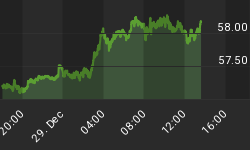Summary
The prices-paid component of the March ISM manufacturing index was bad. However, the one in the April index was even worse. This creates just one more hurdle for Greenspan to try to negotiate at today's FOMC meeting.
Yesterday morning, the Institute for Supply Management released its monthly index measuring the economy's manufacturing activity (the "PMI"). The current report covers April, and this is a closely watched series, partially because the ISM is such a highly regarded private-sector organization.
The April PMI came in at 62.4, down ever so slightly from March's reading of 62.5. (The consensus estimate was for something around 63.) This is a diffusion index, constructed such that any reading above 50.0 indicates expansion in the manufacturing sector. But the problem was not in the result's small shortfall from consensus expectations. Rather, it was in the price trends contained in the numbers.
The monthly PMI contains several subsectors, including one that measures "prices paid." This is carefully scrutinized in some circles (certainly in mine), since it has been a good indicator historically of brewing inflationary problems. And in this regard, the April figures were not encouraging. In fact, they extended the trend of prior months -- surely not an encouraging trend, either.
April represented the 26th consecutive month in which prices rose, with the index measuring this component coming in at 88.0 (up 2.0 points from March). The April reading was the highest since November of 1979 -- a time the economy was experiencing high and rising inflation. (As recently as last October, the prices-paid component stood at a much lower 58.5.)
Moreover, ISM said that 77% of its survey respondents reported higher prices during the month, while only 1% reported lower ones. This continued the major change in skew of prior months. In October 2003, the numbers were 26%/9%, versus April 2004's 77%/1%.
The following table examines the ISM prices-paid data over the consecutive seven months ended April. So you can see how the numbers have been trending, data for March and April 2003 are also included.
| INSTITUTE FOR SUPPLY MANAGEMENT PMI INDEX -- TOTAL INDEX AND PRICES-PAID COMPONENT (Prices-Paid Index Not Seasonally Adj.*) | |||||
| Month/Year | Overall Index | Prices Paid Index | Respondents Reporting Higher, Lower, or Unchanged Prices | ||
| Higher | Lower | Unch. | |||
| 04/04 | 62.4 | 88.0 | 77% | 1% | 22% |
| 03/04 | 62.5 | 86.0 | 73% | 1% | 26% |
| 02/04 | 61.4 | 81.5 | 65% | 2% | 33% |
| 01/04 | 63.6 | 75.5 | 54% | 3% | 43% |
| 12/03 | 66.2 | 66.0 | 37% | 5% | 58% |
| 11/03 | 62.8 | 64.0 | 33% | 5% | 62% |
| 10/03 | 57.0 | 58.5 | 26% | 9% | 65% |
| 04/03 | 46.2 | 63.5 | 37% | 10% | 53% |
| 03/03 | 46.6 | 70.0 | 47% | 7% | 46% |
Tomorrow, ISM will report its index that covers activity in the economy's non-manufacturing sector. In recent months, this measure's price component also has shown some disquieting results.
Yesterday's ISM report certainly should be one of the topics of discussion at tomorrow's FOMC policy meeting. I plan to get some thoughts out on this get-together later today.
















